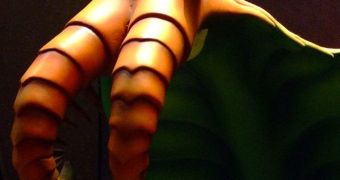A new 3D modeling of the mouth parts of the Anomalocaris, proved that the meters-long, dreadful carnivorous 'shrimp' that was thought to own the seas a half billion years ago, could have been a real softy.
Anomalocaris was believed to have been a fierce predator that fed on trilobites and other creatures of the early seas, after crushing them with its strong mouth parts.
But this new 3D computer model developed by paleontologist James "Whitey" Hagadorn of the Denver Museum of Nature & Science, showed that the creature's mouth parts were not hard like teeth, on the contrary, they were rather flexible.
Also, there is no evidence from fossilized stomach content or feces, that Anomalocaris ate anything that was hard enough to remain fossilized, and Hagadorn even said that the team found absolutely nothing that could suggest any kind of dietary preference.
“It was supposed to roam around the Cambrian seas gobbling up trilobites and everything else,” Hagadorn said.
But apparently, the mouth parts and the whisker-like appendages of Anomalocaris all seem to have been bendable, because their fossil remains were not mineralized like the exoskeletons of the trilobites that were supposed to be their lunch.
Hagadorn developed this 3D model to better understand the mechanism of the Anomalocaris mouth, see how it worked and how much real force it actually had.
What the computer model came up with amazed everyone: the Anomalocaris “couldn't even close its mouth,” Hagadorn said.
Also, there was no way that this mouth could generate the force needed to crush a trilobite shell, and in all 400 Anomalocaris mouths studied, there was absolutely no sign of wear.
And this actually confirms the findings of the 3D model, because if there were genuine teeth, the research would have found chips, scratches or other signs they were being used to chew on hard-shelled animals.
So the 3D model, the gut contents, the feces and teeth wear, all suggest that no trilobite was ever eaten by an Anomalocaris, but none explains what the creature from the Cambrian fed upon.
Hagadorn said that there is a possibility that “it ingested things and then spit them out,” or somehow broke down the food it ate, into minute particles before ingesting it.
Nothing is clear about the diet of the Anomalocaris, but what the team has discovered so far will be presented today, at the annual meeting of the Geological Society of America in Denver.

 14 DAY TRIAL //
14 DAY TRIAL //